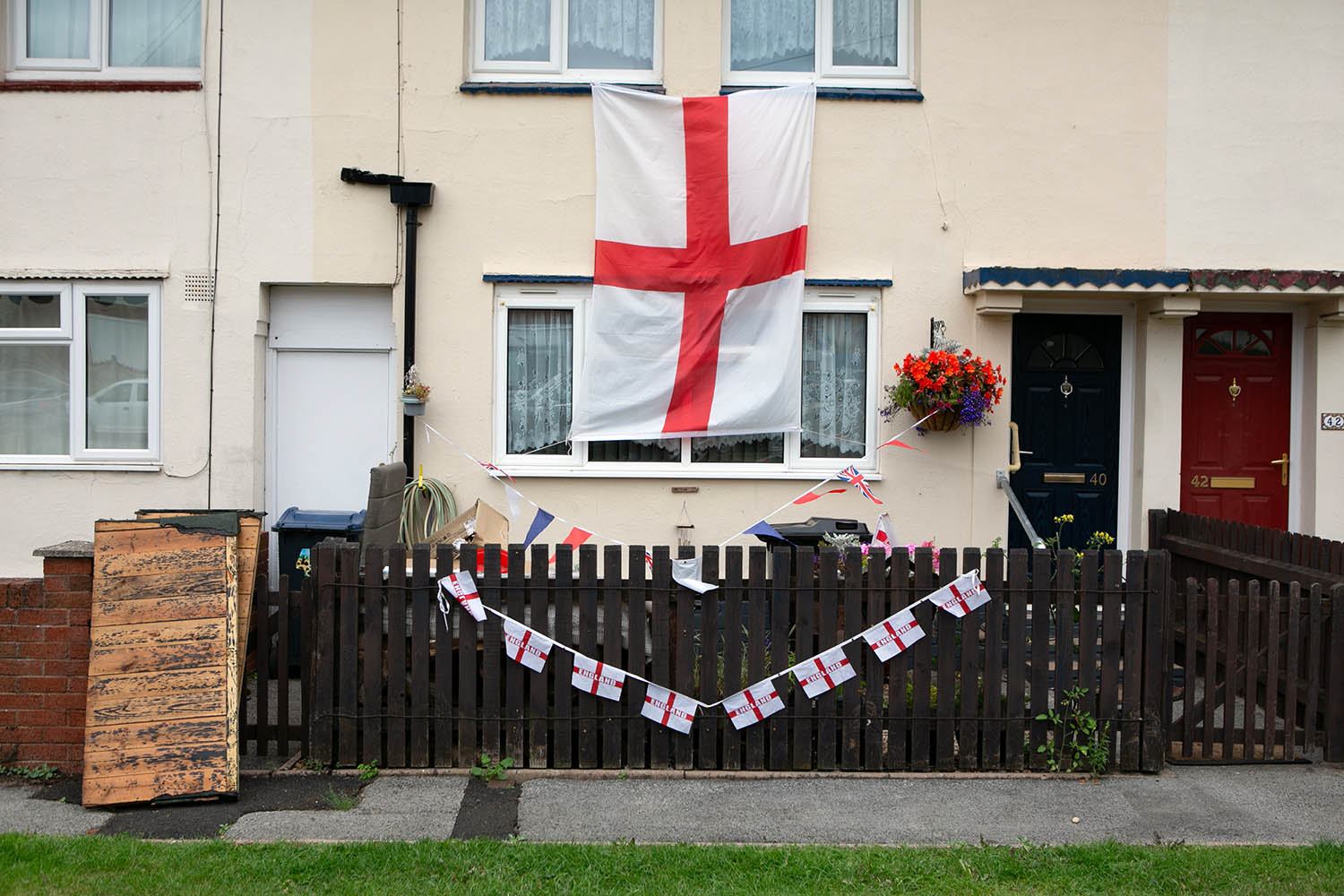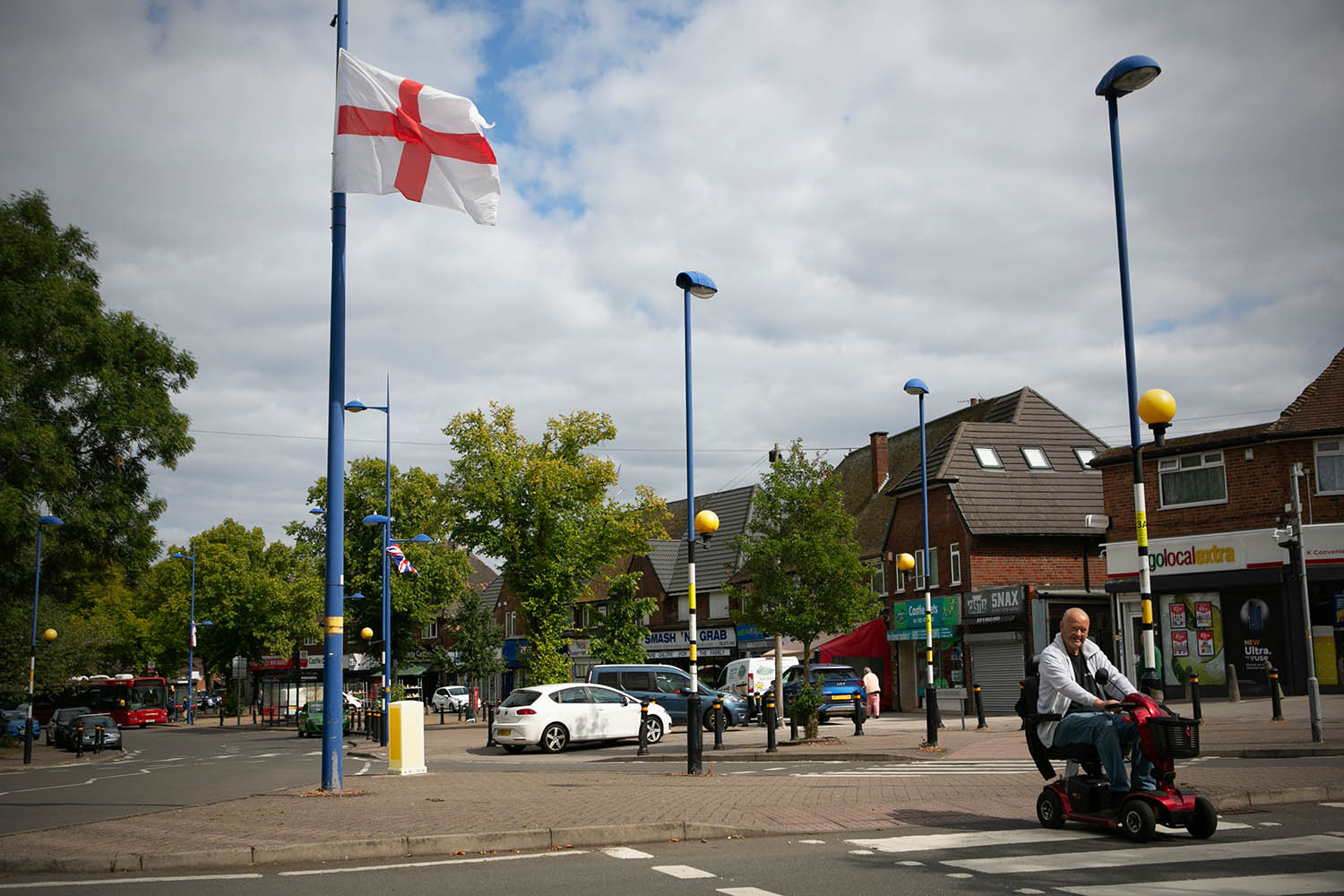As you reach Weoley Castle on the 15-minute drive from Birmingham city centre, the streets suddenly change. It’s not that they’re leafier, more suburban or more ethnically homogeneous, but that all the lampposts are adorned in union flags and St George’s crosses, as if a national celebration were under way on a curiously local level.
Weoley (pronounced “wee-lee”) is the centre of what some see as a colourful patriotic trend and others as a disturbing nationalist movement that in recent days has spread to towns and cities as far apart as Newcastle, Bristol and Norwich.
Birmingham city council has identified the flags as “dangerous” and said it will remove them for safety reasons. In a city that has been enduring a long and unpleasant refuse collection strike and where local authority funds are in short supply, this swift civic reaction immediately inspired online memes of rubbish bags and pot holes emblazoned with the St George cross – as if its unacceptable presence guaranteed prompt action.
Many of those that were subsequently removed have been quickly replaced.
“The council had workers going round removing them in the daytime,” says local resident and care worker Emma Evans, “and in the evening some of those workers have been going round putting them back up again.” Exactly what this flag-placement signifies and who is behind it is the subject of dispute, but if Samuel Johnson was right, and patriotism is the last refuge of the scoundrel, it’s no surprise that an online movement called Operation Raise the Colours has been promoted by far-right figures such as Tommy Robinson.
However, standing in Castle Square, Robert Eden, a longtime resident, is adamant that there is absolutely no bigotry involved. “If I thought they were racist,” he says, “I would go up every lamppost, wherever they are, and rip them down. They just want them to be racist to have something to say. They just want to complain.”
Who are “they”?
“Basically,” he says, lowering his voice conspiratorially, “the Muslims.”
There are certainly no complaints from two local Muslim cab drivers I speak to. “I can’t see the problem,” one says. “If people want to be patriotic, let them. Some think it’s far-right, but I don’t think it is.”
Jeet Singh, a local Sikh, says much the same. And two black students originally from London, Carlton Jackson and Nathan Ola, are resolutely untroubled. “I saw one guy put up a flag and I asked him about it, and he said he was just representing where we come from,” says Jackson. “I thought, yeah, I can’t really complain. In other areas, like Perry Barr, you see Palestinian flags.”
According to retired fireman Lee Wells, it was the proliferation of such flags in areas of the city like Sparkhill that provoked the display in Weoley Castle.
He thinks the St George’s crosses, including those that have been painted on mini-roundabouts, are “good fun that stick two fingers up to the establishment”. A group that calls itself the Weoley Warriors claims responsibility for fixing the flags to the lampposts. Wells knows a number of them, he says. “It’s a response to the Palestinian flags,” he maintains, before adding, “and migrants.”
Far more local people speak of the pride and pleasure the flags arouse, rather than of feelings of prejudice. It’s this half-whispered anti-migrant message that drove young local Jacob Watson to write a letter of complaint to the council. “I just feel it’s a far-right gesture, a kind of overbearing overzealousness that would make other people feel uncomfortable,” he explains while waiting for his bus.
Has anyone actually expressed their discomfort to him?
“Not necessarily discomfort,” he admits, “but my brother and mother agree that the intention is potentially a far-right statement, and potentially anti-immigrant.”
Of course that’s the nature of symbols, they’re full of potential, ready to be employed for all manner of uses, stated and unstated, unifying and dividing, benign and malign. The radical American comedian George Carlin once expressed his scepticism about flag-waving by saying that he left “symbols to the symbol-minded”.

St George flags hang outside a home in Weoley Castle
Wise advice but in politics, especially when cultural and identity battles are raging, some symbols are too temptingly symbolic for any side to leave alone. And you don’t need to be a vexillologist to know the contested symbolism of the English and British flags.
Back in 2014, the then Labour leader Ed Miliband sacked Emily Thornberry from the opposition front bench after she tweeted a photograph of a house with three England flags from where she was canvassing in the Rochester byelection.
Nigel Farage, then leader of Ukip, claimed that Thornberry’s tweet was emblematic of the hatred felt by the so-called metropolitan liberal elite towards expressions of patriotism. Ukip won that byelection and now its descendant, the Farage-led Reform UK heads the polls. Sometimes the most effective way to influence the political weather is to run a flag up a pole and see who salutes it. And better still, see who tries to tear it down.
Reform councils have already announced that they won’t remove any from the districts they control. Labour councils may see it as an issue but Keir Starmer has so far given this red-and-white elephant trap a wide berth, with his spokesperson saying the prime minister “absolutely” supported people flying the St George’s cross and emphasised the importance of patriotism. Shadow justice secretary Robert Jenrick shared a photo of himself putting up a flag in his constituency.
The most telling response in Weoley Castle comes from a couple of sisters, Katherine Starkie and Louise Harper who happen to be discussing the flags when I approach. “We don’t know why they’ve been put up,” Starkie says, wondering if it’s something to do with football or rugby. “So I don’t really have an opinion... I think i f I knew why, I would have an opinion.”
Lampposts used to be for lighting streets and for dogs to pee on. Now they carry the weight of rather too much symbolism.
Photographs by Richard Saker/The Observer

